 We are starting to hear more people talk about issues related to the pelvic floor, and this is a really good thing. Pregnancy, childbirth, episiotomy, fibroids, chronic coughing, menopause, weight gain or inactivity all can contribute to decreased tone, strength, and flexibility of the pelvic floor. When this happens we can experience symptoms of urinary or stool incontinence or other problems related to pelvic organs such as sagging or prolapse, low back pain, painful intercourse, etc. Since the most common is urinary incontinence, most women can relate to the experience of leaking urine, whether during pregnancy, postpartum, or as they get older. And for many, exercising is where it rears it’s ugly head.
We are starting to hear more people talk about issues related to the pelvic floor, and this is a really good thing. Pregnancy, childbirth, episiotomy, fibroids, chronic coughing, menopause, weight gain or inactivity all can contribute to decreased tone, strength, and flexibility of the pelvic floor. When this happens we can experience symptoms of urinary or stool incontinence or other problems related to pelvic organs such as sagging or prolapse, low back pain, painful intercourse, etc. Since the most common is urinary incontinence, most women can relate to the experience of leaking urine, whether during pregnancy, postpartum, or as they get older. And for many, exercising is where it rears it’s ugly head.
According to recent research about 30%-40% of women have problems with urine leakage while exercising, to the point where it bothered them. That is a very high percentage, but the number is probably much higher, if you think about it. As Dr. Virginia Smith, an OBGYN with Kaiser Permanente told Oregon runner/blogger Kelly Barten, “The main problem [with exercise-induced urinary incontinence] is that is often limits women from doing activities that they would otherwise participate in, because of the worry and inconvenience that the incontinence causes.” In other words, there are many women who don’t run or do other forms of impact exercise because of exercise-induced urinary incontinence, which means they often aren’t even included in the studies to begin with.
Traditional exercises, such as Kegels teach isolating the pelvic floor muscles to strengthen them. While Kegels can be very helpful, this approach isn’t the end-all for pelvic floor functioning. And in fact, for some women, it has not proven to be effective in helping significantly with stress or urge incontinence or other pelvic difficulties. Any study of the anatomy of this area reveals that the pelvic floor muscles do not work alone. They are helped, or facilitated, by the muscles of the lower abdomen, inner thighs, hips and buttocks. These muscles are called auxiliary or synergistic muscles of the pelvic floor. The appropriate involvement of the whole body will help you to develop the full function of the pelvic floor.
Also, depending on the activity, the pelvic floor muscles work in different ways. They support the hips and legs in actions such as balancing, walking and other forms of exercise. They help maintain continence and control of the bowels and urine by contracting when you don’t want to eliminate and relaxing when the time is right. In order for a baby to be born, the mother’s pelvic floor relaxes and even stretches. The pelvic floor muscles support the internal organs and are obviously involved with sexual health and function. There are many different functions and different ways the pelvic floor reacts.
So what do we do about exercise induced stress incontinence? There are three things that we can do now to start addressing this important issue. Number one: educate ourselves. Instead of waiting for problems to get big, or not exercising in the way we would like, we need to be knowledgable about our options. There are lots of good resources out there. Here are a few of my favorites (please let me know of others that you are aware of):
National Incontinence, Aligned and Well (Katys Blog), the Kegel Queen, the National Association of Continence.
Number two: workout our core. I know we hear a lot about the core, and maybe it’s even a little ambiguous. But if we just started by concentrating on squats and planks…we can strengthen those important supporting muscles like the glutes and abs. Whenever we strengthen the muscles around the pelvic floor, we are helping to strengthen and support the pelvic floor.
Number three: do those Kegels. We don’t have to do them ad naseum as maybe we have heard in the past. In fact, I have stopped doing them “anywhere” like lots of folks say we should. I try to do them three to four days a week before I go to bed (when I am lying down) or in the morning before I get out of bed. I have to concentrate on finding my pelvic floor muscles by really thinking about them (which is why I’ve started to only do them lying down).
Not talking about the issue hasn’t helped women over the years, so we should be relieved that many are finally talking. Knowledge is powerful, and in this case, if we have the motivation, also effective.
What are you doing to become more knowledgable? Please share!





Speak Your Mind